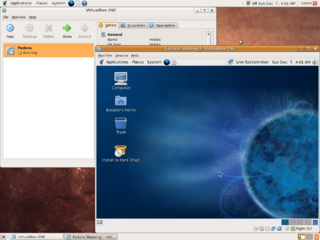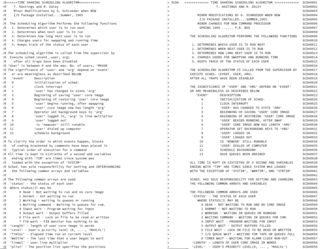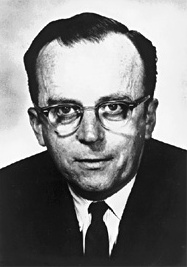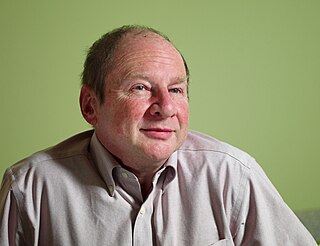
Multics is an influential early time-sharing operating system based on the concept of a single-level memory. Nathan Gregory writes that Multics "has influenced all modern operating systems since, from microcomputers to mainframes."
SNOBOL is a series of programming languages developed between 1962 and 1967 at AT&T Bell Laboratories by David J. Farber, Ralph Griswold and Ivan P. Polonsky, culminating in SNOBOL4. It was one of a number of text-string-oriented languages developed during the 1950s and 1960s; others included COMIT and TRAC. Despite the similar name, it is entirely unlike COBOL.

In computing, time-sharing is the concurrent sharing of a computing resource among many tasks or users by giving each task or user a small slice of processing time. This quick switch between tasks or users gives the illusion of simultaneous execution. It enables multi-tasking by a single user or enables multiple-user sessions.

In computing, a virtual machine (VM) is the virtualization or emulation of a computer system. Virtual machines are based on computer architectures and provide the functionality of a physical computer. Their implementations may involve specialized hardware, software, or a combination of the two. Virtual machines differ and are organized by their function, shown here:
TYPSET is an early document editor that was used with the 1964-released RUNOFF program, one of the earliest text formatting programs to see significant use.

Malcolm Douglas McIlroy is an American mathematician, engineer, and programmer. As of 2019 he is an Adjunct Professor of Computer Science at Dartmouth College. McIlroy is best known for having originally proposed Unix pipelines and developed several Unix tools, such as echo, spell, diff, sort, join, graph, speak, and tr. He was also one of the pioneering researchers of macro processors and programming language extensibility. He participated in the design of multiple influential programming languages, particularly PL/I, SNOBOL, ALTRAN, TMG and C++.

The Compatible Time-Sharing System (CTSS) was the first general purpose time-sharing operating system. Compatible Time Sharing referred to time sharing which was compatible with batch processing; it could offer both time sharing and batch processing concurrently.

Joseph Carl Robnett Licklider, known simply as J. C. R. or "Lick", was an American psychologist and computer scientist who is considered to be among the most prominent figures in computer science development and general computing history.
In computer science, pattern matching is the act of checking a given sequence of tokens for the presence of the constituents of some pattern. In contrast to pattern recognition, the match usually has to be exact: "either it will or will not be a match." The patterns generally have the form of either sequences or tree structures. Uses of pattern matching include outputting the locations of a pattern within a token sequence, to output some component of the matched pattern, and to substitute the matching pattern with some other token sequence.
Incompatible Timesharing System (ITS) is a time-sharing operating system developed principally by the MIT Artificial Intelligence Laboratory, with help from Project MAC. The name is the jocular complement of the MIT Compatible Time-Sharing System (CTSS).

Fernando José "Corby" Corbató was an American computer scientist, notable as a pioneer in the development of time-sharing operating systems.

John McCarthy was an American computer scientist and cognitive scientist. He was one of the founders of the discipline of artificial intelligence. He co-authored the document that coined the term "artificial intelligence" (AI), developed the programming language family Lisp, significantly influenced the design of the language ALGOL, popularized time-sharing, and invented garbage collection.

Harold Abelson is an American mathematician and computer scientist. He is a professor of computer science and engineering in the Department of Electrical Engineering and Computer Science at the Massachusetts Institute of Technology (MIT), a founding director of both Creative Commons and the Free Software Foundation, creator of the MIT App Inventor platform, and co-author of the widely-used textbook Structure and Interpretation of Computer Programs, sometimes also referred to as "the wizard book."

Computer Science and Artificial Intelligence Laboratory (CSAIL) is a research institute at the Massachusetts Institute of Technology (MIT) formed by the 2003 merger of the Laboratory for Computer Science (LCS) and the Artificial Intelligence Laboratory. Housed within the Ray and Maria Stata Center, CSAIL is the largest on-campus laboratory as measured by research scope and membership. It is part of the Schwarzman College of Computing but is also overseen by the MIT Vice President of Research.

Wallace "Wally" Feurzeig was an American computer scientist who was co-inventor, with Seymour Papert and Cynthia Solomon, of the programming language Logo, and a well-known researcher in artificial intelligence (AI).
Victor H. Yngve was a professor of linguistics at the University of Chicago and the Massachusetts Institute of Technology (1953-1965). He was one of the earliest researchers in computational linguistics and natural language processing, the use of computers to analyze and process languages. He created the first program to produce random but well-formed output sentences, given a text, a children's book called Engineer Small and the Little Train.

Bob Fabry founded the Computer Systems Research Group (CSRG) in the EECS Department at the University of California, Berkeley in 1979. The BSD software developed at CSRG helped spawn the Open Source movement and facilitated the explosion of the internet. The success of the BSD programming environment led to a number of Unix-like systems which replaced the portions of the BSD code that were subject to AT&T copyright. The Linux system is perhaps the most well-known of these and about half of the utilities that it comes packaged with are drawn from the BSD distribution.
Douglas Taylor "Doug" Ross was an American computer scientist pioneer, and chairman of SofTech, Inc. He is most famous for originating the term CAD for computer-aided design, and is considered to be the father of Automatically Programmed Tools (APT), a programming language to drive numerical control in manufacturing. His later work focused on a pseudophilosophy he developed and named Plex.
Software studies is an emerging interdisciplinary research field, which studies software systems and their social and cultural effects. The implementation and use of software has been studied in recent fields such as cyberculture, Internet studies, new media studies, and digital culture, yet prior to software studies, software was rarely ever addressed as a distinct object of study. To study software as an artifact, software studies draws upon methods and theory from the digital humanities and from computational perspectives on software. Methodologically, software studies usually differs from the approaches of computer science and software engineering, which concern themselves primarily with software in information theory and in practical application; however, these fields all share an emphasis on computer literacy, particularly in the areas of programming and source code. This emphasis on analysing software sources and processes often distinguishes software studies from new media studies, which is usually restricted to discussions of interfaces and observable effects.

Software is a set of programmed instructions stored in the memory of stored-program digital computers for execution by the processor. Software is a recent development in human history and is fundamental to the Information Age.











